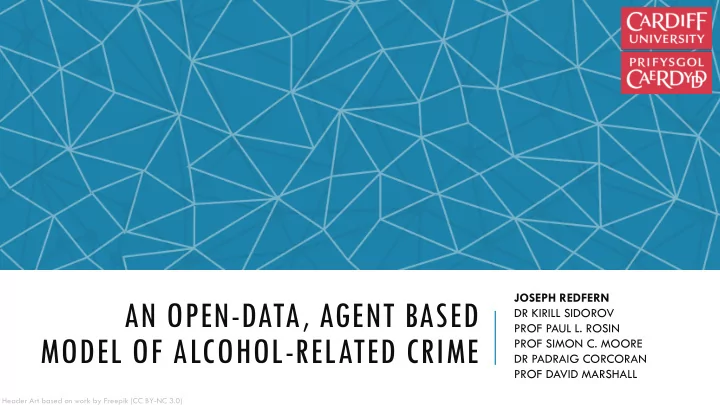

JOSEPH REDFERN AN OPEN-DATA, AGENT BASED DR KIRILL SIDOROV PROF PAUL L. ROSIN MODEL OF ALCOHOL-RELATED CRIME PROF SIMON C. MOORE DR PADRAIG CORCORAN PROF DAVID MARSHALL Header Art based on work by Freepik (CC BY-NC 3.0)
MOTIVATION >€10 9 PER YEAR ~40,000 Nurses ~33,000 Police Officers https://iea.org.uk/wp-content/uploads/2016/07/DP_Alcohol%20and%20the%20public%20purse_63_amended2_web.pdf
MOTIVATION >€10 9 PER YEAR ~800,000 >10,000 NVIDIA ~40,000 Nurses ~33,000 Police Macbook Pros Officers DGX-1 Systems https://iea.org.uk/wp-content/uploads/2016/07/DP_Alcohol%20and%20the%20public%20purse_63_amended2_web.pdf
MOTIVATION Injuries incurred can be life-changing. Bad reputation could deter visitors/spending. Planning for novel scenarios or designing cities can be hard – no existing data. Assist police/city planning efforts to reduce risk.
RESEARCH QUESTION “Without historical data, can we predict areas at-risk of alcohol-related violence in cities?”
EXISTING WORK: HOTSPOT ANALYSIS Kernel Density estimation (or similar) of historical crimes. Commonly used in Crime Reduction strategies. Increased police presence in high- risk areas to deter crime. http://www.ucl.ac.uk/jdi/events/int-CIA-conf/ICIAC11_Slides/ICIAC11_1C_SChainey
EXISTING WORK: HOTSPOT ANALYSIS + Can work well, given existing historical data. + Computationally inexpensive. + Evidence-based, easily interpreted. - Requires historical crime data for given area. - Less effective for novel scenarios/events.
EXISTING WORK: SIMDRINK SimDrink, Scott et al (2016) Simulates drinking in Melbourne. Agents move between bars and consume alcohol. Simulates alcohol consumption, tracks agent finances, models availability of transport. Measures various “harms” incurred by agents. Includes violence, drinking too much, having difficulty getting home. http://jasss.soc.surrey.ac.uk/19/1/10.html
EXISTING WORK: SIMDRINK + No historic crime data required. + Simulation produces realistic output. + Possible to run “what if” scenarios. - Produces aggregate figures. - True geography not considered, cannot localise hotpots. - New cities/simulation areas require new set of parameters.
OUR SOLUTION: OVERVIEW Graph-constrained, agent-based model. Agents (representing people) move around road network. Consume alcohol at pubs/bars/clubs. Track blood-alcohol concentration (BAC). Use pedestrian density and BAC as a proxy to predict risk of violence – common assumption, likely valid. Implemented using Python (graph-tool) and Postgres (PostGIS).
OUR SOLUTION: DATA SOURCES (I) OpenStreetMap Open, collaboratively generated map of the world. Data includes nodes (like vertices), and ways (like edges) forming roads. Easily parsed into a graph/network. Agents traverse this network when moving around the city. Easy to modify OSM data to add new roads, venues etc http://wiki.openstreetmap.org/wiki/Finland:Traffic_signs
OUR SOLUTION: DATA SOURCES (II) FourSquare and Google Places OSM road data typically excellent – venue data can be poor. Out-of-date venue names, incorrect opening times, missing data. Foursquare and Google provide APIs for their own data. Includes venue location, opening times. Query these APIs to supplement OpenStreetMap data.
OUR SOLUTION: AGENT DESCRIPTION (I) Each agent has a number of properties, some fixed (calculated once for each agent at run-time), some dynamic (changing throughout the simulation) Name Type Description Gender Fixed P(male) == P(female) == 0.5 Mass Fixed Sampled from Normal Distribution Home Location Fixed Randomly sampled from OSM Residential Streets Drinking Rate Fixed Randomly sampled from cut-off normal distribution. Time spent per venue Fixed Time spent per venue, sampled from cut-off normal distribution. Session Duration Fixed Overall duration of drinking session, sampled from cut-off normal distribution.
OUR SOLUTION: AGENT DESCRIPTION (II) Each agent has a number of properties, some fixed (calculated once for each agent at run-time), some dynamic (changing throughout the simulation) Name Type Description Previous Drinks Dynamic Timestamped list of drinks consumed Current Route Dynamic The current route being followed (if any) BAC Dynamic (Derived) Derived from Gender, Mass and Previous Drinks (using Widmark Formula)
OUR SOLUTION: AGENT BEHAVIOUR Agents move from their home locations (determined from OSM data). Visit a venue, consume drinks at a particular rate, and move to a new venue (or go home) according to individual agent preferences. Shortest path considered (avoiding major roads). When a venue closes, the agents leave the venue. Opening/closing time data from Google Places & Foursquare.
OUR SOLUTION: MODEL OUTPUT We divide the simulation area into grid cells (typically 250x250m – a reasonable area to patrol). For each cell, we calculate the total number of seconds that each agent has been present. We then multiply agent-second count by average BAC of the agents within the cell. This value is used as our simulated risk level. Risk
EVAULATION DATA Crime Data provided by Northampton Police Force (UK). Officer location history over 3 years. 2 minute-intervals, includes lat/lon, officer status, crime type We consider violence against a person & rowdy behavior (not Heatmap of Violence against a Person and Rowdy Behaviour for Saturdays necessarily caused by alcohol). in Northampton.
EVAULUATION METHOD Apply same 250x250m grid to ground-truth data. Count instances of violence against the person and rowdy behaviour occurring during given weekday and given time window. Run Pearson’s R and Spearman’s ρ correlation measures on cell-wise basis.
OUR SOLUTION: RESULTS Reasonable correlation measures Weekday Pearson’s r Spearman’s ρ P-value r: 0.634 Mon 0.558 0.565 <0.001 ρ : 0.611 Tue 0.584 0.610 <0.001 Varies by day of week Weds 0.683 0.647 <0.001 Particular peaks on Wednesday, Friday and Saturday Thurs 0.651 0.609 <0.001 Likely due to Wednesday, Friday and Saturday Fri 0.664 0.632 <0.001 being busier nights – higher SNR. Sat 0.733 0.696 <0.001 Friday and Saturday weekend nights, more Sun 0.565 0.517 <0.001 drinking. Results for Northampton City Centre, 10,000 agents, 18:00-04:00 Wednesday often social night at Universities.
CONCLUSION Our results show a reasonable level of correlation between ground-truth data and simulation output. Suggests that agent-based modelling has promise for predicting levels of alcohol-related crime without requiring historical data, with minimal manual data input required. Potential for use by police, city planners and Alcohol licensing officials as preventative measure.
FUTURE WORK Group Behaviour & Demographics Different drinking styles with different groups/venues, “pre - drinking” Routing Strategy Venue Capacities Taxis, Public Transport (and associated queues) Fast-food outlets/hotels Incorporate some ideas presented in SimDrink: Influence of Peers, Spending limits Learning of agent parameters Need to ensure model still generalises well Improve performance evaluation method
Recommend
More recommend